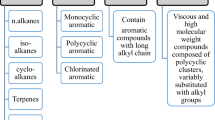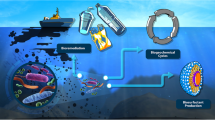Abstract
Quinoline (Q) and some isomers of methylquinoline (MQ) were transformed to hydroxylated products in freshwater sediment slurries incubated under methanogenic conditions at 25 °C. Methylquinoline transformation was not affected by a methyl group on the C-3 or C-4 carbon atom of the pyridine ring; 2-MQ, however, was not transformed. All isomers of dimethylquinoline (DMQ) tested (2,4-, 2,6-, 2,7-, and 2,8-DMQ) with a methyl group at the number 2 carbon also persisted in sediments after anaerobic incubation for one year at 25 °C.
In most experiments, quinoline initially was transformed to 2-hydroxyquinoline (2-OH-Q), which was further metabolized to unidentified products. A second product, 4-CH3-2-OH-Q, was detected in some experiments. This product accumulated and was not further transformed. 6-, 7-, and 8-Methylquinoline (6-, 7-, 8-MQ) were hydroxylated to form the respective 2-OH-MQ products. These hydroxylated products accumulated and were not further transformed. Hydroxylation of Q and 6-, 7- and 8-MQ at the 2-carbon position was confirmed by GC/FTIR and GC/MS analyses. The transformations of Q and MQs were pH dependent with an optimal pH of 7–8.
The results of this study suggest that two pathways may exist for the anaerobic transformation of quinoline; one pathway leads to the formation of a hydroxylated intermediate and the other to a methylated and hydroxylated intermediate. In addition, our results suggest that a methyl substituent on the number 2 carbon inhibits the anaerobic transformation of quinoline derivatives.
Similar content being viewed by others
Abbreviations
- GC:
-
gas chromatography
- GC/FTIR:
-
gas chromatography/Fourier transform infrared spectrometry
- GC/MS:
-
gas chromatography/mass spectrometry
- HPLC:
-
high performance liquid chromatography
- MQ:
-
methylquinoline
- Q:
-
quinoline
References
Aislabie J, Bej AK, Hurst H, Rothenburger S & Atlas RM (1990) Microbial degradation of quinoline and methylquinolines. Appl. Environ. Microbiol. 56: 345–351
Bollag JM & Kaiser JP (1991) The transformation of heterocyclic aromatic compounds and their derivatives under anaerobic conditions. Crit. Rev. Environ. Control. 21: 297–329
Francis CW & Wobber FJ (1982) Status of health and environmental research relative to solid wastes from coal conversion. U.S. Department of Energy, Washington, DC. DOE/NBB-0008/I
Gangual SK (1981) Gas chromatographic investigation of raw wastewater from coal gasification. J. Chromatogr. 204: 439–444
Godsy EM, Goerlitz DF & Grbic-Galic D (1992) Methanogenic biodegradation of creosote contaminants in natural and simulated ground-water ecosystems. Ground Water 30: 232–242
Hale DD, Rogers JE & Wiegel J (1990) Reductive dechlorination of dichlorophenols by nonadapted and adapted microbial communities in pond sediments. Microb. Ecol. 20: 185–196
Hanson RL, Carpenter RL & Newton GJ (1979) Chemical characterization of polynuclear aromatic hydrocarbons in airborne effluents from an experimental fluidized bed combuster. In: Bjorseth A & Dennis AJ (Eds) Polynuclear Aromatic Hydrocarbons: Chemistry and Biological Effects. Battelle Press, Columbus, OH
Leenheer JA, Noyes TI & Stuber HA (1982) Determination of polar organic solutes in oil-shale retort water. Environ. Sci. Technol. 16: 714–723
Neufield RD & Spinola AA (1978) Ozonation of coal gasification plant wastewater. Environ. Sci. Technol. 12: 470–472
Pereira WE, Rostad CE, Garbarino JR & Hult MF (1983) Groundwater contamination by organic bases derived from coal-tar wastes. Environ. Toxic. Chem. 2: 283–294
Pereira WE, Rostad CE, Updegraff DM & Bennett JL (1987a) Fate and movement of azaarenes and their anaerobic biotransformation products in an aquifer contaminated by wood-treatment chemicals. Environ. Toxicol. Chem. 6: 163–176
Pereira WE, Rostad CE, Updegraff DM & Bennett JL (1987b) Anaerobic microbial transformations of azaarenes in ground water at hazardous waste sites. In: Averett RC & McKnight DM (Eds) Chemical quality of water and the hydrologic cycle (pp 111–123). Lewis Publishers, Inc., Chelsea, MI
Pereira WE, Rostad CE, Leiker TJ, Updegraff DM & Bennett JL (1988) Microbial hydroxylation of quinoline in contaminated groundwater: Evidence for incorporation of the oxygen atom of water. Appl. Environ. Microbiol. 54: 827–829
Reinhardt CF & Britteli MR (1981) Heterocyclic and miscellaneous nitrogen compounds. In: Clayton GD & Clayton FE (Eds) Patty's Industrial Hygiene and Toxicology, Vol. IIA (pp 2761–2763). John Wiley and Sons, Inc., New York
Shelton DR & Tiedje JM (1984) General method for determining anaerobic biodegradation potential. Appl. Environ. Microbiol. 47: 850–857
Shukla OP (1986) Microbial transformation of quinoline by aPseudomonas sp. Appl. Environ. Microbiol. 51: 1332–1342
Stuermer DH, Ng DJ & Morris CJ (1982) Organic contaminants in groundwater near an underground coal gasification site in north-eastern Wyoming. J. Environ. Sci. Technol. 16: 582–587
Wang Y, Suidan MT & Pfeffer JT (1984) Anaerobic biodegradation of indole to methane. Appl. Environ. Microbiol. 48: 1051–1060
Author information
Authors and Affiliations
Rights and permissions
About this article
Cite this article
Liu, SM., Jones, W.J. & Rogers, J.E. Biotransformation of quinoline and methylquinolines in anoxic freshwater sediment. Biodegradation 5, 113–120 (1994). https://doi.org/10.1007/BF00700636
Accepted:
Issue Date:
DOI: https://doi.org/10.1007/BF00700636




